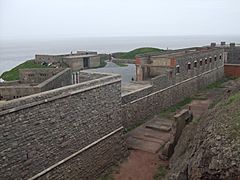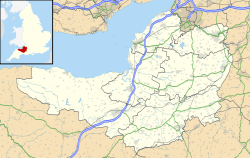Brean Down Fort facts for kids
Quick facts for kids Brean Down Fort |
|
|---|---|
| Somerset, England | |
 |
|
| Coordinates | 51°19′38.03″N 3°02′00.08″W / 51.3272306°N 3.0333556°W |
| Site information | |
| Owner | National Trust |
| Open to the public |
The site remains unlocked at all times, with volunteers manning buildings on summer weekends and Mon, Wed, Fri in summer school holidays |
| Site history | |
| Built | 1864–1871 rearmed in World War II |
| In use | 1871–1901, 1940–1945 |
| Garrison information | |
| Garrison | Coast Brigade, Royal Artillery |
Brean Down Fort is a historic fort built on a headland called Brean Down. It stands about 18 metres (60 feet) above the sea. You can find it about 14 kilometres (9 miles) south of Weston-super-Mare in Somerset, England.
This spot has been important for a very long time. People first lived here during the Early to Middle Bronze Age.
The fort you see today was built in the 1860s. It was part of a group of forts called Palmerston Forts. These forts were made to protect important ports in the Bristol Channel. Brean Down Fort stopped being used in 1901.
However, during World War II, it was used again. It was armed with new weapons and became a place for testing experimental weapons.
Since 2002, the National Trust has owned the fort. They spent £431,000 to fix it up. The fort is now part of their Brean Down property and is open for everyone to visit.
The fort has also been a filming location. It appeared in an episode of the BBC show Bonekickers. It was also used for scenes in the 1978 HTV series The Doombolt Chase.
Contents
Ancient History of Brean Down
Life in the Bronze Age
The earliest signs of people living at Brean Down are from the Early to Middle Bronze Age. This was a time thousands of years ago when people used bronze for tools and weapons. The land here has changed a lot since then. What was once a settlement is now an exposed cliff due to sea erosion.
Archaeologists have found many items from the Bronze Age at the site. These include pieces of pottery and jewellery. Most of these old treasures are now kept safe at the Museum of Somerset in Taunton. Experts have also found signs of a possible roundhouse, which was a common type of home in the Bronze Age.
Roman Era Discoveries
Later, during the Roman Empire period, Romans also visited or lived near Brean Down. Evidence of their presence includes gold and silver coins. These coins feature the faces of Roman emperors like Augustus, Nero, Drusus, and Vespasian. A special ring made of cornelian stone was also found. These finds show that the site was important for a very long time.
Building the Palmerston Fort
Why the Fort Was Built
Brean Down Fort is one of the many Palmerston Forts. These forts were built along the Bristol Channel to defend places like Bristol and Cardiff. The idea for these forts came after Queen Victoria and Prince Albert visited France. They were worried about how strong the French Navy was becoming.
Because of these worries, a special group called the Royal Commission on the Defence of the United Kingdom was set up. This group, led by Lord Palmerston, suggested building forts along the coast. Brean Down Fort was a key part of this defence plan. It helped protect the channel between the mainland and the islands of Steep Holm and Flat Holm.
Construction and Early Use
In 1862, four acres of land at the end of Brean Down were taken for the fort. Building started in 1864 and finished in 1871.
The fort first had seven large guns. These were 7-inch (17.8 cm) rifled muzzle-loading guns. They were some of the last of their kind made. These guns were placed in three main spots. One spot, called W battery, had two guns that could rotate. Each gun weighed 7 tons. They could fire a 51 kg (112 lb) shot at 475 metres (1560 feet) per second. This shot could break through 20 cm (8 inches) of armour from 914 metres (1000 yards away). There was also a huge underground gunpowder room. It was 4.5 metres (15 feet) by 5.5 metres (18 feet) and 6.1 metres (20 feet) high.
About 50 soldiers and officers from the Coast Brigade, Royal Artillery, worked at the fort. However, the guns at Brean Down Fort were never fired in a real battle.
Wireless Communication Record
In 1897, something exciting happened at Brean Down. Guglielmo Marconi, a famous inventor, had been experimenting with wireless radio signals. After sending signals between Lavernock Point in Wales and Flat Holm island, he moved his equipment to Brean Down. From here, he set a new record for wireless transmission over open sea. He sent a signal 14 kilometres (8.7 miles) away!
The Explosion of 1900
The fort's active service ended suddenly on July 6, 1900. At 5 a.m., the No. 3 magazine exploded. This magazine held 3 tons of gunpowder. An investigation suggested that a soldier, Gunner Haines, had fired a bullet down a ventilation shaft. This caused the huge explosion. However, some people have questioned this explanation.
The explosion destroyed a wall separating the fort from its moat. Debris was thrown up to 180 metres (200 yards) away. No one truly understood why the gunner caused the explosion. After this, the cannons were removed using large traction engines.
The fort was then used as a café by the Hillman family from at least 1907 until 1936. Later, it was sold to a group that managed a bird sanctuary.
Brean Down Fort in World War II
Re-arming the Fort
When World War II began, Brean Down Fort was brought back into use. It was rearmed with two large 6-inch (15 cm) naval guns and two searchlights. These were used as a Coastal artillery battery to protect the coast.
New gun positions were built for these large guns. These spots were later covered with a special "plastic" roof to protect against air attacks. One gun position was built over the old west battery ruins. The other partly covered the north-west battery. The old barrack buildings were changed, and windows were partly blocked. This was to reduce damage from explosions. Other buildings were also added outside the original fort. These included searchlight batteries to light up enemy ships and a command post. Barracks for the soldiers were also built.
The fort was manned by soldiers from the 365 and 366 Coast Batteries of the 571st Coast Regiment, Royal Artillery. These units were formed in December 1941 and stopped operating in April 1944.
Experimental Weapons Testing
Brean Down was also a secret test site for new weapons. The British Admiralty's Directorate of Miscellaneous Weapons Development used the fort for trials. One piece of evidence left behind is a short length of launching rail. This rail was designed to launch a special type of bomb.
Some of the interesting weapons tested here included:
- The seaborne Bouncing bomb: This bomb was designed to bounce across water to hit targets like dams, avoiding underwater nets.
- AMUCK: An anti-submarine missile.
- The expendable acoustic emitter: This device was designed to confuse enemy noise-seeking torpedoes.
Gallery







